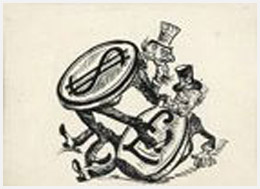EDUCATION
Basically a self-taught artist, it`s the village sculptors
and the puppet-players who inspired him. 1932-36 Chittagong
Govt. College, Bangladesh. 1960s Learnt the techinques
of Czech puppetry from Mr. Frantisek Salaba, a Czech
amateur puppeteer who lived in Bombay.
EXHIBITIONS
1956 His first major exhb. at Prague, Czechoslovakia.
Various Exhibitions in Denmark, Holland, Germany, Copenhagen,
USA. 1979 Exhb. of his graphic art at the Fronta Gallery
in Spalena Street in Prague, the organisers of this
exhb. are the National Gallery in Prague, the Czechoslovak-
Indian Section of the Czechoslovak Society for Foreign
Relations and the Publishing House Mlada Fronta. 1980
Retrospective organised after his death, was the biggest
of his exhb., Czechoslovakia. 1980 Exhb. at Calcutta
Information Centre, organised by Chittaprosad Art Archive,
Chittabharati, Calcutta and The Department of Information
and Cultural Affairs, Govt. of West Bengal. 1981 Largest
exhb., featured his works acquired by Pragues National
Gallery, since 1956 with the help of the artist`s personal
friends. 1992 Exhb. for organizing Chitta Bharati and
celebrating Chittaprosads birthday, The Centre Art Gallery
and Chitrakoot Art Gallery, Calcutta. 1992 Exhb. of
selected cartoons and drawing
COLLECTION
Ebrahim Alkazi & Art Heritage, New Delhi. National
Gallery of Modern Art, New Delhi. Prague Museum of Art,
Czechoslovakia. Jane and Kito de Boer, Dubai. Neville
Tuli, Bombay. Goodricke Group Limited, Calcutta and
London. Delhi Art Gallery, New Delhi.
AWARDS
13th November, 1978 Chittaprosad Art Archieve, an institute
of research on Chittaprasads life and works, was established,
Chandi Ghosh Road, Calcutta. 4th December, 1978 Felicitation
program was organized by Shilpayan, Mime Academy, Calcutta.
1992 Chitta Bharati organisation was organised in his
honour.
STYLE
Chittaprosad was the leader of a distinct trend in
the National Art Movement of India. He was an artist
of the people- the great multitude of India; poverty
ridden, exploited, and the victims of every possible
circumstance, but of unbounded vitality, keepers of
its unique cultural heritage with a legacy of hundreds
of years of stoic survival against all odds. His works
varied from time to time, responding to the subjects
he was dealing with. The main theme of his works revolved
around the society he was living in, infact he picturised
the darker side of life, which seemed to be very expressionistic.
His style is not blindly realistic; it has a folk feeling,
as well as a complete affinity with the forms integral
to the people.

back |



